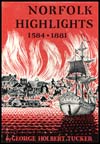Chapter 45
Virginia's First Civil War Engagement
Contrary to popular belief, the first Battle of Manassas (July 21, 1861) was not the first engagement fought in Virginia during the Civil War.
The first skirmish, the little known Battle of Sewells Point, was fought on May 18-19, 1861, on ground now occupied by the Norfolk Naval Station.
The events leading up to the initial engagement on Virginia soil had moved with whirlwind rapidity.
On December 20, 1860, South Carolina became the first state to secede from the Union. Four months later, on April 12, 1861, troops of the same state opened fire on Fort Sumter in Charleston harbor, bringing a quick request from President Lincoln for volunteers to march against the rebelling states.
Five days later, Virginia became the eighth Southern state to withdraw from the Union. And on April 21, 1861, the Gosport Navy Yard (now the Norfolk Naval Shipyard) was abandoned and partially burned by the Federal forces, leaving only Fort Monroe at Old Point Comfort as the last bastion of the United States in Tidewater Virginia.
Stewart's "History of Norfolk County, Virginia" (1902), contains a detailed account of the Battle of Sewells Point that took place one month later. Shorn of unnecessary details, this is what happened:
On May 18, 1861, Norfolk-area and Georgia Confederate troops began erecting land batteries at Sewells Point opposite Fort Monroe on Hampton Roads.
By 5 o'clock that evening, three guns and two rifled guns had been mounted and work was rapidly progressing on the fortifications when the USS Monticello, commanded by Captain Henry Eagle, steamed over from Fort Monroe to see what was afoot.
Not liking what he saw, Captain Eagle gave the order to open fire. One of the shots from his vessel hit the battery, throwing turf high in the air.
In the meantime, the Monticello had been joined by an armed tug, also from Fort Monroe.
The bombardment from these two vessels caused momentary confusion in the breastworks, but once the Confederates had recoverd from the initial shock, immediate preparations were made to return the fire from their two 32-pounders and the two rifled guns already in position.
In the absence of a Confederate or Virginia flag, Captain Peyton H. Colquitt of the Light Guard of Columbus, Georgia, who was in charge of the erection of the battery, called for the raising of the Georgia flag on the Sewells Point ramparts.
Under the cover of darkness, the armed tug returned to Fort Monroe, but the Monticello remained off Sewells Point with her guns pointed in the direction of the Confederate fortifications.
During the night, frantic efforts were made to complete the breastworks, and it was not until the next day at around 5:50 in the afternoon, when the sound of axes being used to secure the Confederate gun carriages could be plainly heard aboard the Monticello, that the bombardment was resumed. It continued until 6:45 p.m.
In the end, the Monticello, with several gaping holes in her hull from well-aimed Confederate shots, limped back to Fort Monroe. The first engagement on Virginia soil during the Civil War was over.
There were no fatalities on either side. The only person wounded was Confederate Private Alexander Sykes of the Wise Light Dragoons, who was struck by a fragment of a bursting shell.
Subsequently the Sewells Point batteries were under fire many times, but they were never silenced or captured in combat. And when Norfolk was evacuated by Confederate forces on May 10, 1862, they were abandoned.
Chapter
46
Lincoln Plans the Recapture of Norfolk
Norfolk Highlights 1584 - 1881

See the "Table of Contents" for links to every chapter in Norfolk Highlights 1584 - 1881 by George Holbert Tucker.
